Japan
Wood Products Prices
Dollar Exchange Rates of 10th
April
2019
Japan Yen 112.00
Reports From Japan
¡¡
Private consumption held back by slow
wage growth
Revised figures show that Japan¡¯s economy expanded in
the last quarter of 2018 mainly due to increased capital
expenditure. The final quarter 2018 figures indicate that
there was a rebound in growth following a series of natural
disasters that resulted in a steep slowdown.
Despite the positive numbers on overall growth, private
consumption, which traditionally accounts for a large slice
of the economy, barely moved as disappointing wage
growth cut household spending.
Looking ahead, Japanese business confidence was
assessed at a two-year low in the first quarter of 2019,
largely the result of weak global demand and declining
imports in China.
The negative sentiment was most obvious among large
companies where sentiment dropped at its fastest pace in
more than six years. Continued weakness of the Japanese
economy will likely ensure the Bank of Japan maintains,
or even expands, its stimulus policy.
Short-term rise in machinery orders
The value of machinery orders received by 280
manufacturers operating in Japan increased by 5.4% in
February compared to a month earlier. Private-sector
machinery orders, excluding those for ships and from
electric power companies, increased a seasonally adjusted
by 1.8% in February.
A government official told a press conference that an order
for a large ship engine was the main factor lifting the
February data. Despite the rise, the Cabinet Office
maintained its assessment for the third consecutive month
that orders are "stalling". Machinery orders are considered
a leading indicator of capital expenditure, a key driver of
Japanese economic growth in recent months.
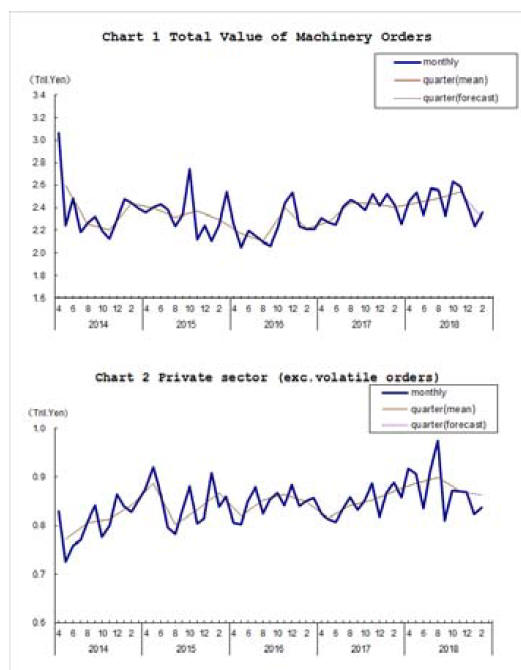
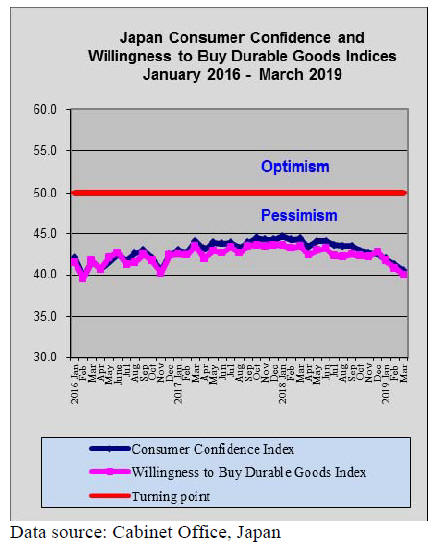
Bank of Japan tightening forecast by
economists
A group of economists were recently surveyed on their
opinion as to whether the Japanese government will raise
the consumption tax in October this year as planned. Most
thought yes and most raised concerns about this pushing
the economy into recession. The government is aware of
this risk and has planned a yen 2 trillion budget to boost
spending.
In the same survey most economists said they believe the
Bank of Japan will soon begin easing away from its loose
monetary policy. The impact of this on exchange rates
could be significant; a strengthening of the yen is the most
likely outcome.
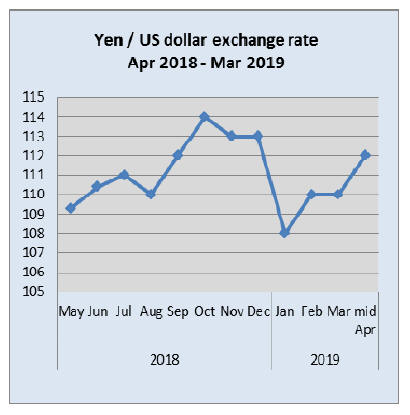
Encouraging housing starts in past 3 months
Year on year, February housing starts rose 4.2% the third
consecutive year. The increase was led by starts for
owner-occupied housing and condominiums.
Starts for owner-occupied housing, such as custom-built
houses, rose 10%, the fifth year on year rise. Interest rates
continue to be very low in Japan and banks are willing to
extend loans as they try and increase business.
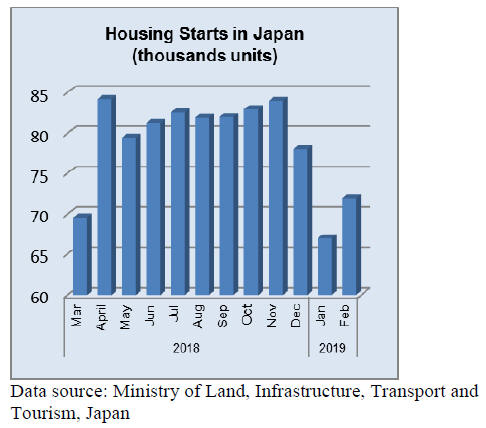
Wooden door imports
Year on year, the value of Japan¡¯s February wooden door
imports dropped 6% and compared to the value of imports
in January there was a 7% decline in February.
In February shippers in three countries accounted for 90%
of all wooden door imports with China delivering 64% of
the total, the Philippines 20% and a further 6% was
shipped from suppliers in Indonesia.
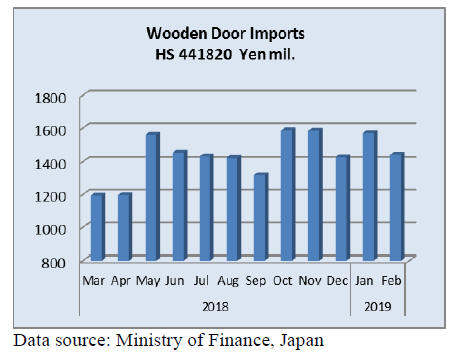
Wooden window imports
As was the case with wooden doors, the value of Japan¡¯s
imports of wooden windows declined year on year and
month on month (-6% and -22% respectively).
As in previous months the top shippers were in China, the
US, the Philippines and Sweden. Shipments from China in
February accounted for 40% of all wooden window
arrivals followed by the US (24%) the Philippine (20%)
and Sweden. The top four delivered 97% of the total value
of Japan¡¯s wooden window imports in February.
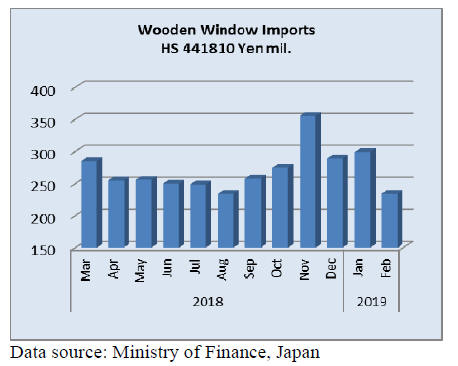
Assembled wooden flooring imports
The value of assembled flooring imports nosedived in
February with year on year imports dropping 17% and
month on month there was a 19% decline.
In February 2019 imports of HS441875 accounted for
75% of all imports in the range of HS441871-79. As in
previous months the main shippers of HS441875 were
China (50%), Indonesia (28%) and Thailand (13%).
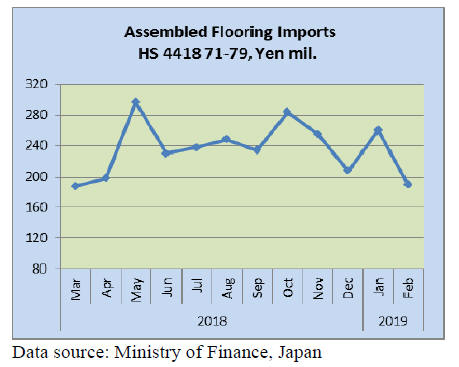
Plywood imports
Despite the intense activity in the construction sector as
Japan readies for the 2020 Olympics, plywood imports in
February were only up 3% year on year and there was a
surprising drop in month on month imports (-3%).
This provides a measure of the growth in domestic
production from domestic logs.
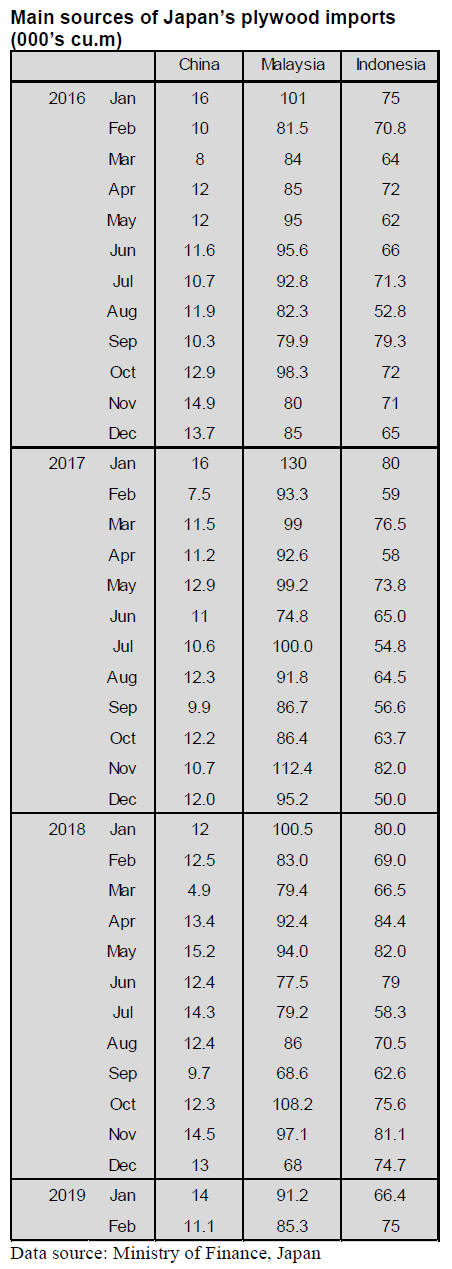
The top three suppliers Malaysia, Indonesia and
China
continue to dominate plywood imports. In February the
volume of plywood imports from Malaysia accounted for
46% of all imports of products in the categories of
HS441810-39.
The other shippers were Indonesia (40%) and China (6%).
Vietnam consistently supplies around 6% of Japan¡¯s
plywood imports. Almost 90% of Japan¡¯s plywood
imports fall within HS 441234.
Trade news from the Japan Lumber Reports (JLR)
The Japan Lumber Reports (JLR), a subscription trade
journal published every two weeks in English, is
generously allowing the ITTO Tropical Timber Market
Report to reproduce news on the Japanese market
precisely as it appears in the JLR.
For the JLR report please see:
http://www.nmokuzai.
com/modules/general/index.php?id=7
European lumber import in 2018
Total import volume of European softwood lumber in
2018 was 2,565,528 cbms, 9.2% less than 2017. This is the
first decline after three years.
In the first half of 2018, the supply volume did not
increase due to robust demand of North America and
China. The market in Japan did not feel supply shortage
and the market lacked vividness.
Supply of whitewood KD stud and other processed lumber
was 858,582 cbms, 7.3% less. Semi-finished products like
genban and lamina were 1,706,941 cbms, 10.2% less. One
of two major suppliers of stud had stayed low supply by
about 20-30% and other supplier skipped the supply for
January, September and November so the export prices
increased from Euro 320-325 per cbm C&F for January
and February shipment to Euro 345 for November and
December shipment.
This is due to oversupply and dropped prices in 2017. The
inventories in Japan did not dropped as much as supply
reduction so the market prices in Japan increased only by
1,000 yen from 47,000-48,000 yen in the first half to
48,000- 49,000 yen in the second half.
Export prices of lamina and genban stayed high due to
high log cost and strong demand by Europe, North
America and China. Lamina prices were Euro 250-260 per
cbm C&F and genban prices were Euro 280-290 per cbm
C&F. On redwood, orders dropped after the third quarter
due to ample supply.
Supply from major sources decreased across the board as
shown in the chart. Scandinavian countries lost supply
volume of lamina in the second half. In central Europe,
supply of quality logs was tight because of clean-up of
blowdown timber and beetle damages so mills were not
able to increase the supply for Japan.
North American lumber import in 2018
Total import of North American lumber in 2018 was
2,066,084 cbms, 6.1% less than 2017. This is five straight
years decline. Compared to recent peak year of 2013, it
was 27.9% less.
Impacted by record high lumber market prices in North
America, import of all major species decreased. SPF was
5.2% less. Douglas fir was 7.8% less. Hemlock was 10.2%
less and yellow cedar (cypress) was 17.1% less.
After North American lumber market nosedived in the
second half of the year, SPF lumber prices dropped but the
prices of all the other species like Douglas fir remained
high. SPF lumber volume in 2018 was 1,300,382 cbms,
lower than recent bottom year of 2014 and this is the
lowest since 2009.
Imported volume of SPF remained the same as 2017 until
October with strong purchase by component companies
then the volume plunged in the fourth quarter after the
export prices dropped sharply.
Douglas fir lumber volume was 387,799 cbms. The supply
from the U.S.A. was 190,863 cbms, only 1.1% less but the
Canadian volume dropped to 196,936 cbms, 13.4% less.
Log harvest was steady in Canada without much negative
factor by weather but strong demand by veneer plants on
the coast tightened log availability and sawmills produced
more hemlock lumber so supply from Canada was much
less.
Hemlock lumber supply was 224,324 cbms, 10.2% less.
Hemlock log harvest in Canada was steady but because of
purchase competition with China, the prices of green
hemlock square and genban soared so in Japan, demand of
preservative treated sill of green hemlock sharply
decreased by high prices.
After the fourth quarter, Chinese purchase slowed down so
the supply volume for Japan increased but the market
prices of KD hemlock weakened by ample supply and
demand for green sill lumber has not come back by high
prices. Cypress lumber was 45,127 cbms, 17.1% less.
South Sea (tropical) logs and Lumber
Sizable logs from both PNG and Sarawak, Malaysia
arrived in late 2018 so plywood mills and sawmills now
carry reasonable amount inventories. Malaysian log prices
go up after 2019 with increase of minimum wage and
harvest tax so it was last minutes rush-in import for
December arrivals and 2019 will be different with high prices.
PNG log export prices are weak in general as main buyer,
China is curtailing log purchase. China buys
all the harvested logs from forest while Japan buys
selected logs so prices of mersawa logs selected for
plywood remain high. Some sawmills started using low
priced dillenia from PNG for lumber. Inventory of
laminated free board finally drop so new orders are placed.
January plywood supply
Total plywood supply in January was 515,500 cbms, 2.8%
less than January 2017 and 4.6% more than December
2018.
Domestic production continued steady from beginning of
the year with 258,400 cbms, 0.7% more and 2.4% less.
Imported plywood supply in January was 257,000 cbms,
6.1% less and 12.8% more.
In domestic production, softwood was 247,500 cbms,
0.8% more and 2.1% less. In this, non-satructural panel
production was 19,400 cbms, 25.6% more and 0.9% more.
Despite decrease of total production, production of nonstructural
panel maintained the same as December to
respond to increasing orders of floor base by floor
manufacturers.
Shipment of softwood plywood was 271,300 cbms, 7.6%
more and 5.1% more. Shipment of non-structural plywood
was 19,300 cbms, 22.5% more and 14.0% more. The
inventories of softwood plywood were 114,200 cbms,
20,900 cbms drop from December. The inventories have
been dropping for four straight months since last October
after they increased to 179,300 cbms in September last
year.
Imported plywood in January increased by 9.7%. 93,200
cbms from Malaysia, 9.9% less and 32.0% more. 76,400
cbms from Indonesia, 12.7% less and 7.2% less. 65,200
cbms from China, 2.6% more and 19.2% more. 22,100
cbms from others, 16.0% more and 9.7% more. Usually,
January arrivals are high because of the delayed custom
clearance from December.
Compared to monthly average arrivals to December and
January arrivals from Malaysia and Indonesia, Malaysian
was 81,900 cbms, 7.4% less and Indonesian was 79,400
cbms, 2.5% less so the decrease was small.
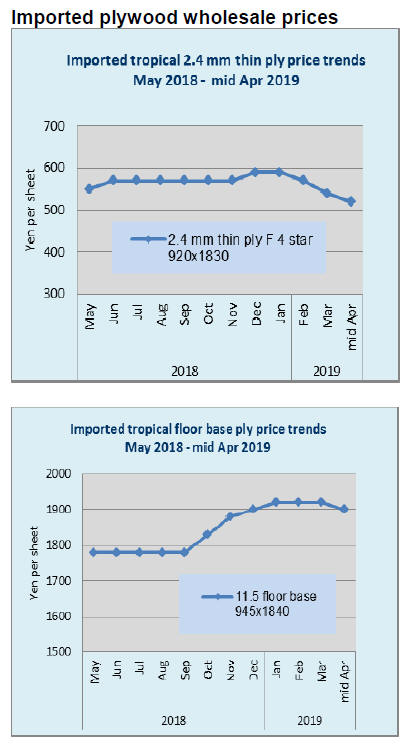 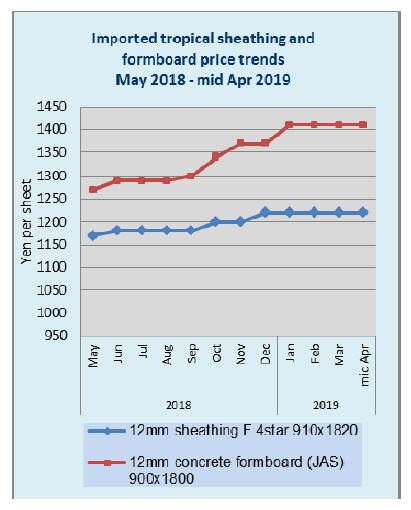
Mitsubishi Real Estate built condo with CLT
Mitsubishi Real Estate (Tokyo) completed building 10
stories rental condominium building in Sendai. This is the
first high rise condo with CLT floor. By using CLT,
building time is shortened by three months.
In ten stories building, CLT is used as floor for fourth to
tenth floor and also part of bearing wall of first and fifth
floor. Some posts are one hour and two hour fire proof.
CLT floor is wrapped with fire proof film but Mitsubishi
Estate intentionally used wood in many places and some
are exposed. Actually some rooms with wooden interior is
classified as premium grade and rental is higher than the
others. It made survey through potential users and they are
willing to pay 5% premium for wood used rooms.
|